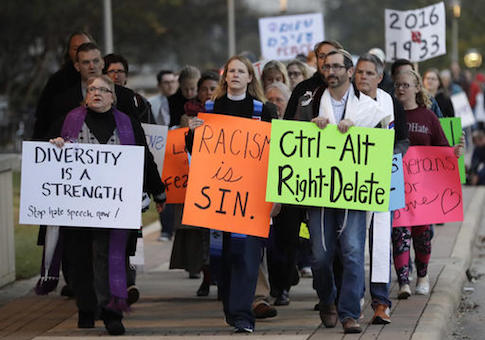The New York Times has published more than two-dozen articles about the "alt-right" and white nationalist movements since the November elections, an invaluable signal boost for the tiny coalition of racists.
The Times has published articles about an "energized" far-right for over a year, although it ramped up this publicity blitz in November after the election of Donald Trump and appointment of Breitbart News executive Stephen Bannon as presidential counselor.
The articles typically refer to the alt-right as an attractive and growing political force—valuable promotional copy for a movement that numbers in the "thousands," as its leaders admit.
On November 1, the Times profiled a "prominent" white nationalist who recorded robocalls to attack independent conservative Evan McMullin and promote Donald Trump. He spent $2,000 total on the calls.
Five days later, the Times wrote about how "Donald Trump's [Alt-Right] Supporters Feel Like Winners." The article described white nationalism as a "once obscure and now ascendant" force experiencing a "surge of interest" due to Trump.
It cited Jared Taylor, another "prominent" white nationalist, who said "traffic to his website, American Renaissance, was up 30 percent" during the election. American Renaissance did grow in popularity in 2016, although it was starting from a very low base. It is currently the 15,732nd most-trafficked website in the United States, according to Alexa.
Shortly after the election, the Times reported that white nationalists were experiencing "an awakening" due to Donald Trump. The article noted that "hundreds" of white nationalists—as many as 270, by some counts—attended a conference by the racist National Policy Institute, where they celebrated "the unexpected march of their white nationalist ideas toward the mainstream."
The Times printed exuberant predictions about the future of white nationalism by conference host Richard Spencer.
"This is what a successful movement looks like," Spencer said about the conference, which attracted fewer attendees than MerFest, a festival for self-described mermaids and mermen.
Spencer is a favorite of the mainstream press, which has written a flood of trend pieces about his fascist-inspired haircut, "dapper" dress, "millennial élan," and "prom king good looks." The Huffington Post wrote that Spencer's face was reminiscent of "Ryan Gosling."
Meet the new think tank in town: The "alt-right" comes to Washington https://t.co/HzWjchaABY pic.twitter.com/CLERkrayWo
— Los Angeles Times (@latimes) November 20, 2016
The New York Times has lavished Spencer with attention, mentioning him at least 11 times in the past two months. Often it has given him space to present his tiny movement as mainstream and normal.
"What you can't say is that we're just a bunch of marginal loons," Spencer said on November 6.
"We've crossed the Rubicon in terms of recognition," he said on November 20.
"My goal for the next five years is professionalization," he said two days later. "That is the next step for the alt-right."
Spencer is not the only alt-righter the Times has boosted in the past two months. It has mentioned internet troll Milo Yiannopoulos five times, profiled an alt-right social media platform, and introduced the world to Matthew Heimbach, who runs a miniscule fascist organization out of his trailer in Indiana. It also wrote that the 2016 election had "resurrected" O.G. racist David Duke, who ran for the Republican Party's Senate nomination in Louisiana—and won 3.4 percent of the vote.
At times the paper has expressed an uneasy awareness that it is helping racists recruit
Before 2016, "the news media often debated whether to cover [the alt-right's] sparsely attended rallies, considering that any attention might grant the groups a veneer of legitimacy," the Times wrote on December 10.
Now, as Democrats seize an opportunity to tie their partisan opponents to outright white nationalists, the media has fewer scruples about covering sparsely attended rallies.
White nationalists are quite pleased with this turn of events, as a Times op-ed pointed out.
"Groups such as Mr. Spencer's, which had indeed rallied behind Mr. Trump, were delighted with the attention … While he does not consider either Mr. Trump or Mr. Bannon alt-right, Mr. Spencer has expressed hope that the press's describing them as such will help his own group grow."
